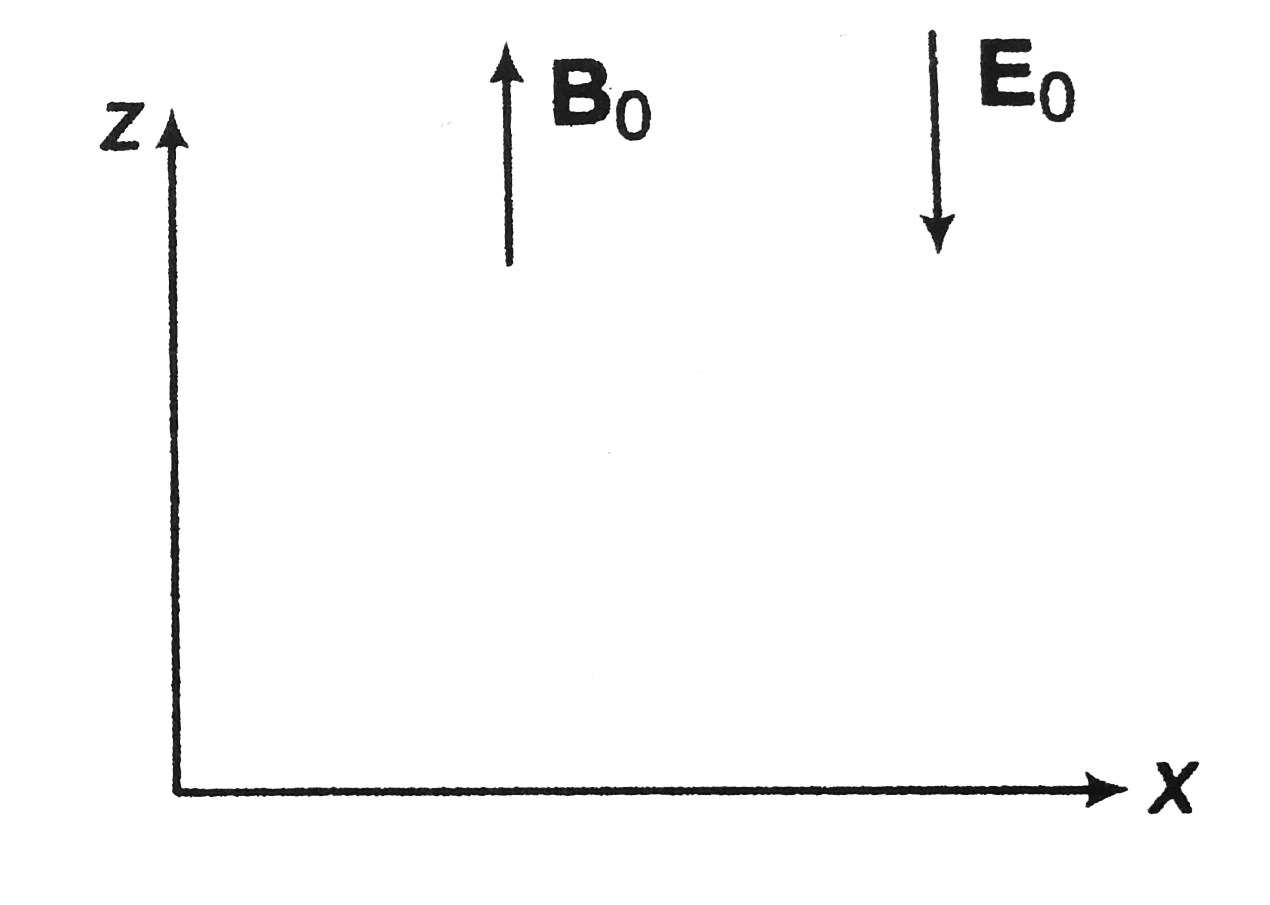Two electromagnetic waves are moving in free space whose electric field vectors are given by →E1=→E0ˆjcos(kx−ωt)&→E2=→E0ˆkcos(ky−ωt). A charge q is moving with velocity →v=0.8cˆj. Find the net Lorentz force on this charge at t=0 and when it is at origin
Option1 E0q(0.4ˆi−3ˆj+0.8ˆk)
Option2 E0q(0.8ˆi−ˆj+0.4ˆk)
Option3 E0q(−0.8ˆi+ˆj+ˆk)
Option4 E0q(0.8ˆi+ˆj+0.2ˆk)
The correct Answer is:4
To find the net Lorentz force on the charge q moving with velocity →v=0.8c^j in the presence of two electromagnetic waves, we will follow these steps:
Step 1: Identify the Electric Fields
The electric fields of the two electromagnetic waves are given as:
→E1=→E0^jcos(kx−ωt)
→E2=→E0^kcos(ky−ωt)
At t=0, these fields become:
→E1=→E0^jcos(kx)
→E2=→E0^kcos(ky)
Step 2: Calculate the Electric Field at the Origin
At the origin (x=0,y=0):
→E1(0,0)=→E0^jcos(0)=→E0^j
→E2(0,0)=→E0^kcos(0)=→E0^k
Step 3: Calculate the Total Electric Field
The total electric field →E at t=0 is:
→E=→E1+→E2=→E0^j+→E0^k=→E0(^j+^k)
Step 4: Calculate the Magnetic Fields
Using the relationship between electric and magnetic fields in electromagnetic waves, we find the magnetic fields →B1 and →B2.
For →E1:
- The direction of propagation is along ^i (x-direction).
- The magnetic field →B1 is given by:
→B1=→E0c^kcos(kx−ωt)
At t=0:
→B1(0)=→E0c^kcos(k⋅0)=→E0c^k
For →E2:
- The direction of propagation is along ^j (y-direction).
- The magnetic field →B2 is given by:
→B2=→E0c^icos(ky−ωt)
At t=0:
→B2(0)=→E0c^icos(k⋅0)=→E0c^i
Step 5: Calculate the Total Magnetic Field
The total magnetic field →B at t=0 is:
→B=→B1+→B2=→E0c^k+→E0c^i=→E0c(^i+^k)
Step 6: Calculate the Lorentz Force
The Lorentz force →F on the charge q is given by:
→F=q(→E+→v×→B)
Substituting the values:
- →E=→E0(^j+^k)
- →v=0.8c^j
- →B=→E0c(^i+^k)
Now, calculate →v×→B:
→v×→B=(0.8c^j)×(→E0c(^i+^k))
Using the cross product:
=0.8→E0(^j×^i+^j×^k)=0.8→E0(−^k+^i)
Step 7: Combine Forces
Now, substitute back into the Lorentz force equation:
→F=q(→E0(^j+^k)+0.8→E0(−^k+^i))
=q(→E0^j+→E0^k+0.8→E0(−^k)+0.8→E0^i)
=q(0.8→E0^i+→E0^j+(1−0.8)→E0^k)
=q(0.8→E0^i+→E0^j+0.2→E0^k)
Final Result
Thus, the net Lorentz force on the charge q at t=0 is:
→F=q→E0(0.8^i+^j+0.2^k)
The electric fields of the two electromagnetic waves are given as:
→E1=→E0^jcos(kx−ωt)
→E2=→E0^kcos(ky−ωt)
→E1=→E0^jcos(kx)
→E2=→E0^kcos(ky)
At the origin (x=0,y=0):
→E1(0,0)=→E0^jcos(0)=→E0^j
→E2(0,0)=→E0^kcos(0)=→E0^k
The total electric field →E at t=0 is:
→E=→E1+→E2=→E0^j+→E0^k=→E0(^j+^k)
Using the relationship between electric and magnetic fields in electromagnetic waves, we find the magnetic fields →B1 and →B2.
- The direction of propagation is along ^i (x-direction).
- The magnetic field →B1 is given by:
→B1=→E0c^kcos(kx−ωt)
At t=0:
→B1(0)=→E0c^kcos(k⋅0)=→E0c^k
- The direction of propagation is along ^j (y-direction).
- The magnetic field →B2 is given by:
→B2=→E0c^icos(ky−ωt)
At t=0:
→B2(0)=→E0c^icos(k⋅0)=→E0c^i
The total magnetic field →B at t=0 is:
→B=→B1+→B2=→E0c^k+→E0c^i=→E0c(^i+^k)
The Lorentz force →F on the charge q is given by:
→F=q(→E+→v×→B)
Substituting the values:
- →E=→E0(^j+^k)
- →v=0.8c^j
- →B=→E0c(^i+^k)
→v×→B=(0.8c^j)×(→E0c(^i+^k))
Using the cross product:
=0.8→E0(^j×^i+^j×^k)=0.8→E0(−^k+^i)
Now, substitute back into the Lorentz force equation:
→F=q(→E0(^j+^k)+0.8→E0(−^k+^i))
=q(→E0^j+→E0^k+0.8→E0(−^k)+0.8→E0^i)
=q(0.8→E0^i+→E0^j+(1−0.8)→E0^k)
=q(0.8→E0^i+→E0^j+0.2→E0^k)
Thus, the net Lorentz force on the charge q at t=0 is:
→F=q→E0(0.8^i+^j+0.2^k)
Topper's Solved these Questions
Similar Questions
Electric field in space is given by −−→E(t)=E0i+j√2cos(ωt+Kz). A positively charged particle at (0,0,πK) is given velocity v0ˆk at t = 0. Direction of force acting on particle is
View SolutionThe electric field of a plane electromagnetic wave is given by
→E=E0(ˆx+ˆy)sin(kz−ωt)
Its magnetic field will be given by :
View SolutionThe electric field of a plane electromagnetic wave propagating along the x direction in vacuum is →E=E0ˆjcos(ωt−kx) . The magnetic field →B, at the moment t=0 is :
View SolutionThe space has electromagnetic field which is given as →B=−B0ˆk and →E=E0ˆk. A charged particle having mass m and positive charge q is given velocity v0ˆi at origin at t=0sec. The z coordinate of the particle when it passes through the z−axis is (neglect gravity through motion)
View SolutionIn a certain region, uniform electric field E=−E0ˆk and magnetic field B=B0ˆk are present. At time t=0, a particle of mass m and charge q is given a velocity v=vj+vk. Find the minimum speed of the particle and the time when it happens so.

View SolutionElectric field and magnetic field n a region of space is given by E=E0ˆj and B=B0ˆj. A particle of specific charge alpha is released from origin with velocity v=v0ˆi. Then path of particle
View SolutionElectric field of an electromagnetic wave →E=E0cos(ωt−kx)ˆj . The equation of corresponding magnetic field at t=0 should be
View SolutionConsider an object of mass m moving in free space with velocity given by →v=v0cosωtˆi+v0sinωtˆj . Here v0 and ω are constants and t represents time. calculate force acting on object and angle between force and momentum.
View SolutionOn the superposition of the two waves given as y1=A0sin(ωt−kx) and y2=A0cos(ωt−kx+π6) , the resultant amplitude of oscillations will be
View SolutionA particle of charge q and mass m starts moving from the origin under the action of an electric field →E=E0ˆiand→B=B0ˆi with a velocity →v=v0ˆj. The speed of the particle will become 2v0 after a time.
View Solution
